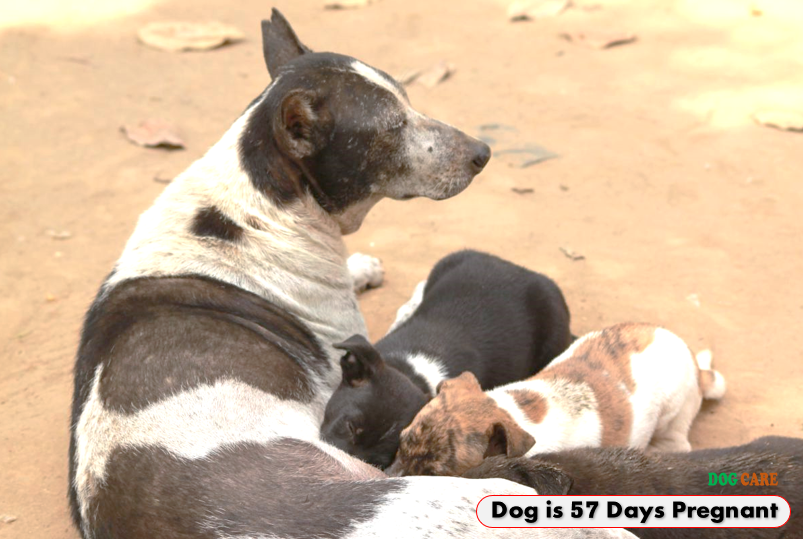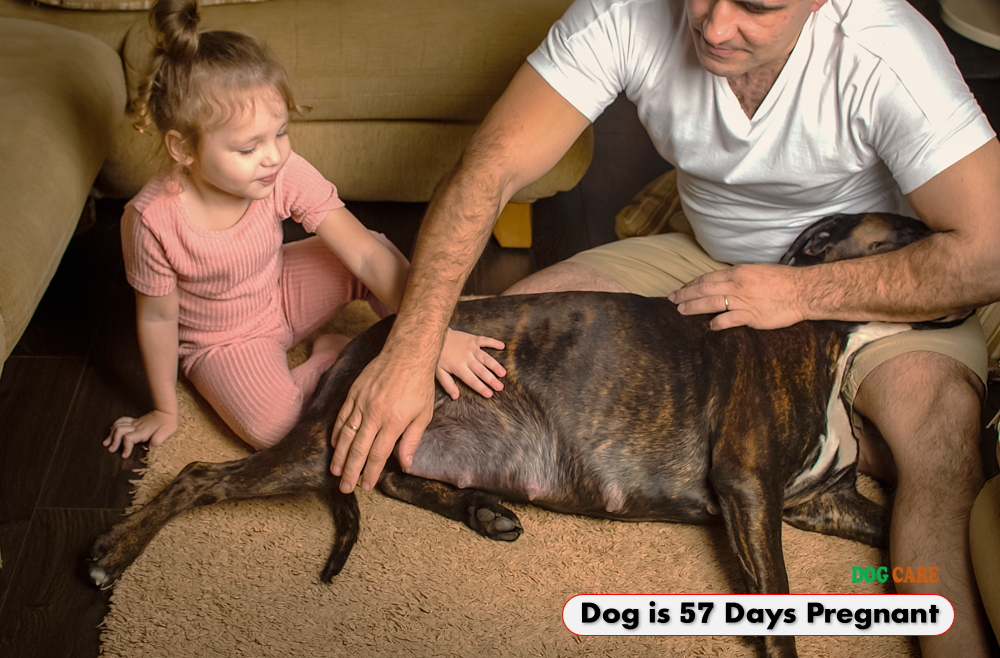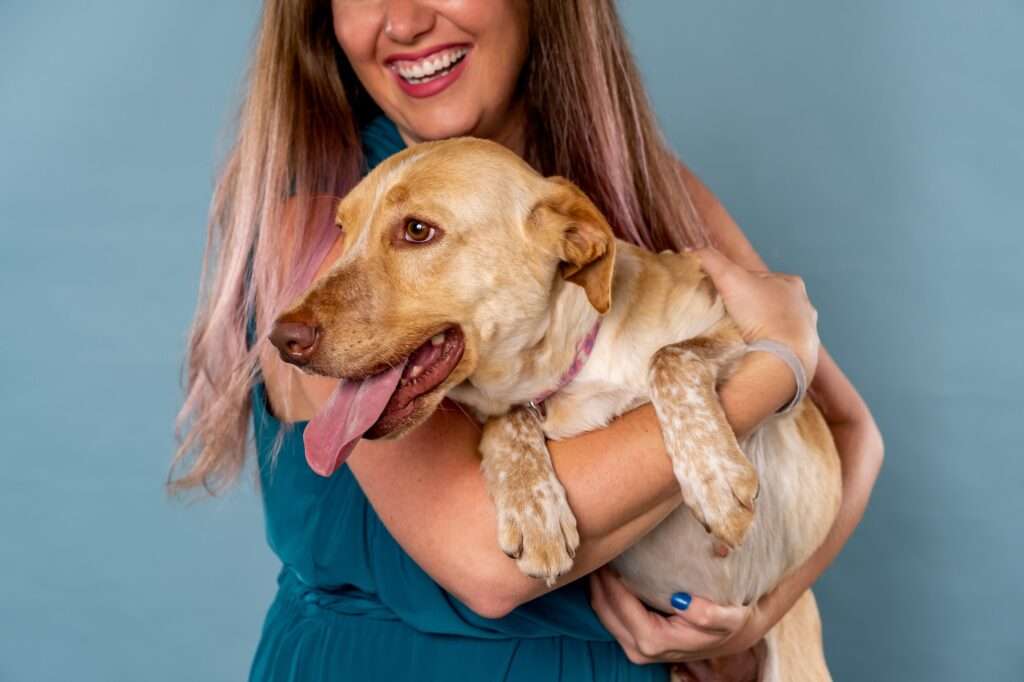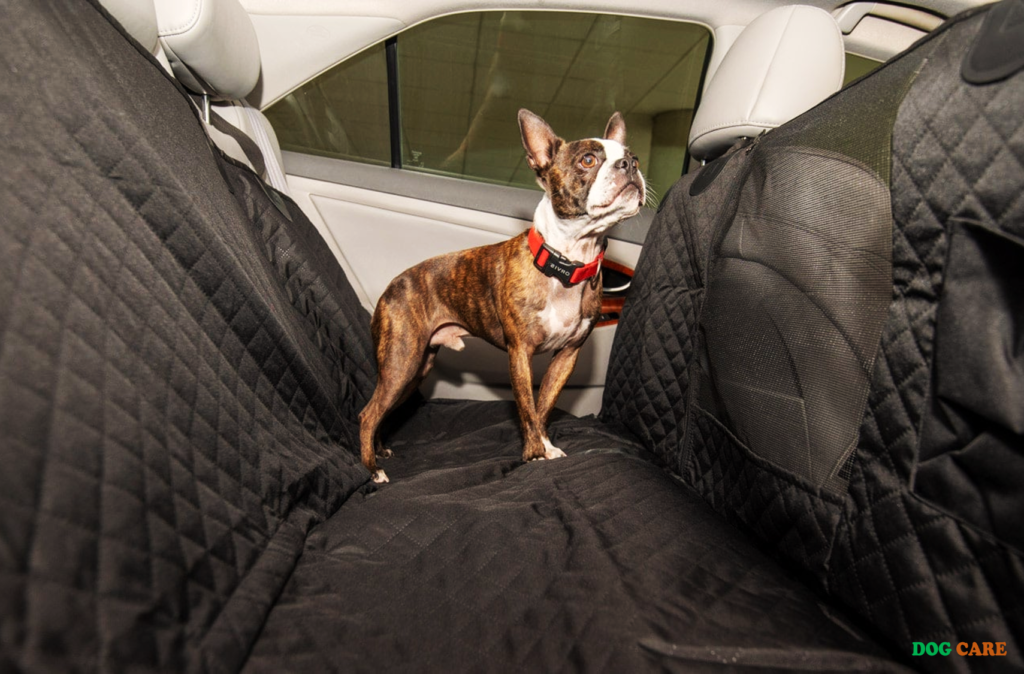My Dog is 57 Days Pregnant What Should i Expect – At 57 days, your dog is nearing the end of her pregnancy, so expect the birth to occur soon. Prepare for potential labor signs which could start any moment.
As a dog owner with a pregnant pooch, these final days are both exciting and critical. Around day 57 of pregnancy, dogs enter the home stretch when puppies are almost ready to greet the world. Observing your dog closely is crucial as she may show signs of nesting or restlessness, which indicates labor is imminent.
Be ready with a comfortable whelping box and maintain a calm environment. Ensure you have your vet’s contact information handy, as complications, though not common, can arise. Keep a close eye on your furry friend for the onset of labor, characterized by behavioral changes and physical cues. The anticipation of new life brings joy, coupled with a responsibility to provide support and care during these concluding days of canine gestation.

Introduction To Canine Pregnancy
Welcome to the fascinating world of canine pregnancy where each stage unfolds new wonders. As your beloved dog reaches 57 days of gestation, excitement grows, as does the anticipation of new life. Navigating through the pregnancy journey can be both thrilling and overwhelming for pet owners. In this guide, we’ll embark on an insightful path to understanding the remarkable process of canine pregnancy, spotlighting the stages your dog will traverse and the general timeline of gestation. Get ready to arm yourself with knowledge that will help prepare you and your furry friend for the incredible moments ahead!
Understanding The Stages Of Dog Pregnancy
Just like humans, dogs experience several stages of pregnancy, each marked by critical developmental milestones for the unborn puppies. It’s paramount that owners comprehend these phases to ensure their pets receive the necessary care. Spanning from fertilization to the final days before labor, dog pregnancy is typically segmented into three stages: early, middle, and late gestation.
During the early stage, subtle signs begin to appear, and your dog may exhibit changes in behavior and appetite. The middle stage highlights rapid fetal growth, while the late stage—where your dog currently is—culminates in the anticipation of delivery. Drawing nearer to the 63-day mark, expect developments like nesting behaviors and physical changes signaling that birth is imminent.
The General Timeline Of A Dog’s Gestation
Delving into the duration of dog pregnancy, one discovers that the journey from conception to birth is generally around 63 days, albeit slight deviations are not uncommon. The gestation period can neatly split into three sections:
- Days 1 to 22: Ovulation and fertilization occur, with embryos migrating to the uterus.
- Days 22 to 42: Vital developmental milestones transpire, with organs and features forming.
- Days 42 to 63: Growth becomes more rapid, and the focus shifts to preparing for birth.
Equipped with this timeline, pet owners can monitor their dog’s progress and adapt to her needs as the due date approaches. As the 57-day mark signifies a venture into the last stage, vigilance is key, and preparations for whelping should be underway.
Physical Changes In The Late Stages
As your beloved canine companion edges closer to the culmination of her pregnancy journey, the anticipation builds over what the final days will bring. The late stages of canine gestation are replete with remarkable physical transformations, preparing both the expectant mother and her human family for the impending arrival of her new litter. Noticing these changes marks an essential step in providing the care and support she needs. Let’s explore these visible cues as the magic number of 57 days ticks by.
Visible Signs Of The Whelping Date Approaching
With the big day fast approaching, certain physical indicators become more apparent, signaling that whelping is imminent. Here’s what you’ll likely notice:
- Increased abdomen size: Her belly appears more pronounced as puppies reach full term.
- Nesting behavior: An instinctive urge to create a safe space for delivery.
- Milk production: Her mammary glands are swollen as they prepare to nourish.
- Drop in body temperature: A notable decrease usually 24 hours before labor.
- Physical discomfort: Restlessness or difficulty finding a comfortable position.
Changes In Behavior As The Due Date Nears
Behavioral shifts offer additional clues that the whelping date is within arm’s reach. Pay close attention to the following:
| Behavioral Sign | Description |
|---|---|
| Pacing | A sign of discomfort or the beginning stages of labor. |
| Licking | Excessive grooming, particularly around her genital area, as labor nears. |
| Seclusion | Seeking solitude or a quiet place away from the hustle and bustle. |
| Change in Appetite | A decrease in food intake as labor approaches. |
| Attention-seeking | A sudden increase in the need for affection and reassurance from her human counterparts. |
By staying vigilant and observant of both the physical and behavioral changes in your dog, you’ll be better prepared to support her through the final stage of pregnancy and into the joys of motherhood.
Health And Nutrition At 57 Days Pregnant
As your dog nears the end of her pregnancy at 57 days, her body is preparing for the arrival of her pups. It is a critical time for the expecting mother, calling for specific attention to health and nutrition to ensure the well-being of both the mother and her unborn puppies. Proper dietary management and nutritional supplementation are essential to support the final stages of pregnancy.
Dietary Adjustments For The Expecting Mother
Modifying the diet of a pregnant dog at this stage is crucial. The focus should be on high-quality, easily digestible food that is rich in proteins and fats. This supports the mother’s increased energy needs and contributes to the puppies’ growth.
- Increase calorie intake by 10-15% to facilitate energy requirements.
- Smaller, more frequent meals can prevent discomfort as the puppies take up more space.
- High-grade commercial dog food or a balanced homemade diet advised by a veterinarian is recommended.
It’s important to keep monitoring the mother’s weight to avoid excessive weight gain, which can lead to complications during delivery.
Supplements And Vitamins For The Final Stages Of Pregnancy
Supplementation can play a vital role in supporting the dog’s health and the development of the fetuses at this late stage of pregnancy. Consultation with a vet is indispensable before introducing any supplements.
- Folic Acid: Often advised to support placenta health and fetal development.
- Calcium: Critical for the development of healthy bones in the puppies; however, calcium should be regulated carefully to avoid an imbalance.
- DHA: Providing DHA supplements can contribute to proper brain development in the puppies.
Continuous access to fresh water is also vital, as dehydration can cause serious health issues, especially in a pregnant dog.
Veterinary Care And Pre-birth Checkups
Approaching the final days of your dog’s pregnancy brings both excitement and a little anxiety. It’s a period that requires careful monitoring and the involvement of a professional. With your loyal companion 57 days into the pregnancy, it’s vital to ensure the well-being of both mother and pups through meticulous veterinary care and pre-birth checkups.
Importance Of Veterinary Supervision During The Final Days
As the due date nears, a veterinary expert’s supervision becomes even more imperative. This care can significantly increase the chances of a smooth delivery and healthy offspring. With the puppies’ development reaching its final stage, a vet can provide crucial insights into their positioning, the mother’s health, and signs to watch for when labor begins. Regular check-ups ensure you’re well-prepared for the birth.
Common Veterinary Procedures At 57 Days Pregnant
At 57 days into pregnancy, your dog will undergo a series of standard veterinary procedures to confirm that both she and her puppies are in good shape. These include:
- Ultrasound: To assess the puppies’ development and detect any abnormalities.
- X-rays: To determine the number of puppies and check for any complications that might require a cesarean section.
- Physical Examination: To evaluate the mother’s health and readiness for the birthing process.
- Blood Tests: To ensure there are no underlying health issues that could affect delivery.
These procedures are pivotal in establishing a safe and controlled environment for whelping. It’s an opportune time to confirm that all necessary supplies are on hand and that you’re equipped to handle the impending birth.
Preparing For The Birth
Your beloved canine companion is about to bring new life into the world, and it’s essential to ensure that the birth goes smoothly. At 57 days pregnant, your dog is nearing the end of her gestation period, and it’s time for you to make the necessary preparations. Creating a comfortable environment for your dog to whelp, and being ready with all the required supplies, can significantly ease the birthing process both for you and your expectant pup.
Setting Up A Whelping Box
As the expected delivery day approaches, setting up a whelping box is your first step in the preparation process. This special area serves as a secure and cozy place for your dog to give birth and care for her puppies during their first few weeks of life.
- Choose an easily cleanable and spacious box — the size will depend on your dog’s breed.
- Line it with comfortable materials like newspapers and soft bedding that can be replaced during and after delivery.
- Position the whelping box in a quiet and warm corner of your home, free from drafts and disturbances.
- Introduce your dog to the whelping box a few weeks before her due date to get accustomed to the space.
Gathering Necessary Supplies And Equipment
Being well-equipped is crucial for a successful whelping. You’ll need to assemble a kit of supplies ahead of time to manage any situation that could arise during the delivery. Below is a checklist of items to prepare:
| Supply | Purpose |
|---|---|
| Clean towels | For drying puppies and clearing fluids |
| Disposable gloves | To maintain hygiene during the birthing process |
| Scissors | For cutting umbilical cords if necessary |
| Antiseptic | To clean scissors and other equipment |
| Thread or dental floss | For tying umbilical cords if needed |
| Thermometer | For monitoring your dog’s temperature prior to labor |
| Heating pad or heat lamp | To keep the puppies warm |
| Feeding bottles and formula | In case the mother can’t nurse her puppies |
Ensure all these items are accessible and stored in a clean, safe place. Stay vigilant and watch for signs of labor, such as restlessness, nesting behavior, and a drop in body temperature. With everything in place, you can look forward to welcoming the new pups into a prepared and supportive environment.

Recognizing The Signs Of Labor
As your dog reaches 57 days of pregnancy, anticipation and excitement grow. It’s critical to be well-informed about the signs of labor to provide the necessary care and support. Knowing what to look out for will help ensure a smooth delivery for your beloved pet. Pay close attention to the physical and behavioral changes your dog exhibits as these are tell-tale signs that puppies are on the way.
Physical And Behavioral Indicators Of Impending Labor
Physical and behavioral indicators are the primary signs that your dog’s body is preparing for the birth of her puppies. Here are key signs that labor is imminent:
- Drop in Body Temperature: About 24 hours before labor, your dog’s body temperature will drop below 100°F (37.8°C). Regularly monitor her temperature to detect this vital sign.
- Behavioral Changes: Your dog might seek isolation, exhibit restlessness, or nest-building behavior as she prepares a safe space for her puppies.
- Loss of Appetite: It’s common for dogs to refuse food up to 24 hours before labor begins.
- Physical Discomfort: Signs such as whimpering, panting, or pacing may indicate discomfort due to contractions and the onset of labor.
- Vaginal Discharge: A clear, mucous-like or blood-tinged discharge can be a precursor to labor.
Stages Of Dog Labor And Delivery
The dog labor and delivery process tends to unfold in distinct stages. Below is a detailed look at each:
- Stage One: During the first stage, your dog will show signs of restlessness and discomfort due to uterine contractions, although no pushing will occur. This stage can last from 6 to 12 hours.
- Stage Two: This is the actual delivery stage, where you’ll notice your dog straining and pushing. The first puppy should appear within 1-2 hours after contractions become visible. There should be brief pauses between deliveries, but if your dog strains for more than an hour without a puppy being born, contact your vet immediately.
- Stage Three: The third stage of labor involves the expulsion of the placenta. You might observe this happening after each puppy is delivered, or it might occur after several puppies are born.
Throughout the labor, maintain a calm and supportive environment for your dog, and keep your veterinarian’s contact info at arm’s reach in case of emergencies. Ensuring you understand these labor signs and stages will help you assist your dog in bringing new life into the world.
Caring For A Dog In Labor
As your dog approaches the 57th day of pregnancy, preparation for labor becomes crucial for her health and comfort. Approaching the due date, your pregnant dog will exhibit signs that she’s about to give birth, such as restlessness, nesting behavior, and decreased appetite. It’s essential to be clear about the role you’ll play – offering support, ensuring a safe environment, and knowing when to step in or seek veterinary help.
How To Provide Comfort During Labor
Providing comfort to your laboring dog can greatly ease her birthing process. Start by setting up a quiet and comfortable whelping area away from the hustle and bustle of the household. This space should be warm, private, and lined with clean blankets or towels for her and the newborns.
- Ensure the room’s temperature is maintained between 75-80°F (24-27°C) to prevent the puppies from getting cold.
- Place the whelping box in a peaceful corner where your dog can labor without disturbance.
- Dim the lights to create a calming atmosphere and play soft music if it appears to soothe her.
- Stay close to provide emotional support but give her space to avoid stress.
- Keep fresh water within reach as your dog may become thirsty during labor.
Maintain a vigilant yet unintrusive presence, offering gentle strokes or soothing words when she appears anxious.
When To Intervene And When To Call The Vet
Recognizing when intervention is needed or when it’s time to call the veterinarian is paramount for the safety and health of your dog and her puppies.
| Intervention Needed | Call the Vet If |
|---|---|
|
|
Gently assist your dog if the situation is not critical, encouraging her to continue the labor. However, if the situation escalates or does not resolve swiftly, contact your veterinarian immediately. Trust your instincts; if something seems off, it’s always better to err on the side of caution.
Aftercare For Mother And Puppies
Welcome to the pivotal stage of canine maternity! At 57 days pregnant, your dog is at the threshold of bringing new life into your home. This phase not only heralds the arrival of adorable puppies but also calls for vigilant aftercare to ensure the health and well-being of the mother and her litter. Let’s delve into the indispensable aftercare for both mother and puppies during this incredible journey.
Immediate Postpartum Care For The Mother
The well-being of the mother dog post-delivery is paramount, as she recovers from the strains of whelping. Close monitoring is essential to detect any signs of postpartum complications such as excessive bleeding, fever, or unusual discharge. Here’s a bullet-point list of steps to ensure optimal care:
- Comfortable Environment: Create a serene space for the mother to rest and nurse. Soft bedding and minimal disturbance aid in her recovery.
- Nutrition: Offer her high-quality, easily digestible food and fresh water to refuel energy and support lactation.
- Health Check: Keep a watchful eye on her for symptoms needing veterinary attention.
- Bonding Time: Allow quiet time for the mother to bond with her puppies, fostering a nurturing ambiance.
Caring For The Newborn Puppies In The First Hours
The initial hours post-birth are critical for the newborn puppies. As they acclimate to the world outside the womb, your attentiveness is crucial. Here are the steps to ensure the puppies’ welfare:
- Warmth: Puppies can’t regulate their body temperature initially. Maintain a warm environment to prevent hypothermia.
- Feeding: Ensure each puppy latches onto the mother properly to receive colostrum, the first vital source of antibodies.
- Hygiene: Keep the whelping box clean and dry to minimize the risk of infection.
- Veterinary Care: Have a vet examine the puppies within the first 24-48 hours to address any health concerns promptly.
Frequently Asked Questions For My Dog Is 57 Days Pregnant What Should I Expect
What To Expect At 57 Days Dog Pregnancy?
Pregnant dogs at 57 days are nearing the end of their gestation, typically showing enlarged abdomens and an increased need for nesting.
Are There Signs Of Impending Labor In Dogs?
Yes, signs may include restlessness, loss of appetite, nesting behavior, and possible temperature drop 24 hours before labor begins.
How To Prepare For Whelping?
Set up a comfortable, quiet whelping box, ensure all necessary supplies are available, and consider a vet checkup to anticipate complications.
Can A Dog Give Birth At 57 Days?
While full term is usually around 63 days, some dogs may give birth slightly earlier, although veterinarians generally consider this premature.
What Is A Dog’s Temperature Before Labor?
A dog’s temperature usually drops below 99 degrees Fahrenheit (around 37. 2 Celsius) within 24 hours before the onset of labor.
How To Recognize Dog Labor Complications?
Recognize labor complications by prolonged labor, distress in the mother, or more than two hours between puppies without any signs of the next one.
How Long Is The Dog Whelping Process?
Whelping duration can vary, generally taking several hours, with intervals between puppies ranging from a few minutes to an hour or more.
Can I Feed My Dog During Labor?
It’s best to avoid feeding your dog during active labor as she may not have an appetite and could vomit, which is a risk during delivery.
What To Do After Puppies Are Born?
After birth, ensure puppies are warm, dry, and nursing properly, and check if the mother is comfortable and attentive to her litter.
Conclusion
As your dog nears the end of her pregnancy, preparation is key. Ensure a comfortable, safe space for her to give birth. Monitor her health closely and have vet contact information on hand. Remember, patience and care during these final days will support a smooth delivery.
Get ready to welcome new life into your home.


